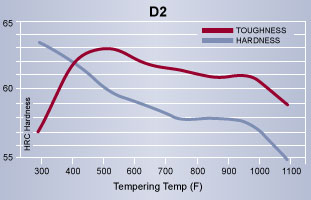Data Sheet - D2
| Typical Composition | ||||
| C | Cr | Mo | V | |
| 1.42 | 11.5 | 0.9 | 0.8 | |
D2 is an air-hardening, high carbon, high chromium tool steel, heat treatable to HRC 60-62. It offers excellent abrasion resistance, due to a large volume of carbides in the microstructure. D2 has been widely used for many years in cold work applications requiring very high wear resistance. It is machinable in the annealed condition and like other air-hardening tool steels, exhibits minimal distortion on hardening.
The Typical Applications include stamping or forming dies, punches and dies, forming rolls, blanking dies, thread rolling dies, coining dies, lamination dies, trim dies, industrial knives and slitters, shear blades, fine blanking tools, scrap choppers, wear parts, tire shredders, and plastic injection feed screws and tips.
| Mechanical Properties | |||||
|---|---|---|---|---|---|
| Heat Treatment Austeniziting | HRC | Impact Toughness | Wear Resitance | ||
| Temp | Ft.-lb | (J) | |||
| D2 | 1850°F(1010C) | 60 | 21 | (28) | 3-4 |
| 150 | |||||
| S7 | 1750°F(955C) | 57 | 125 | (165) | 1 |
| A2 | 1750°F(955C) | 60 | 40 | (53) | 2-3 |
| Cru-Wear | 1950°F(1065C) | 62 | 30 | (40) | 5-6 |
| 3V | 1950°F(1065C) | 60 | 70 | (95) | 7 |
| M2 | 2050°F(1120C) | 62 | 20 | (27) | 8-10 |
| M4 | 2050°F(1120C) | 62 | 32 | (43) | 20-25 |
| 10V | 2150°F(1175C) | 63 | 14 | (19) | 90 |
Machinability
The machinability of D2 as annealed is about 35% of W1 tool steel.
Surface Treatments
D2 can be given standard surface treatments such as nitriding, TiN (titanium nitride) coating or hard chrome plating if desired. When using surface treatments, harden from the high side of the austenitizing range and temper at or above the process temperature of the treatment.
This data sheet is for informational purposes only. Alloy characteristics are subject to change due to chemical composition and/or processing. We do not certify the material’s suitability for specific applications.
Thermal Treatments
Annealing: Heat to 1600°F (870°C), hold 2 hours, slow cool 25°F (15°C) per hour to 1000°F (540°C) then air cool. Or heat to 1600°F (870°C), hold 2 hrs., cool to 1425°F (775°C) hold 6 hrs., then air cool.
Annealed Hardness: About BHN 221/225
Stress Relieving
Annealed Parts: Heat to 1200-1250°F (650-675°C), hold 2 hours, then cool in still air.
Hardened Parts: Heat to 25-50°F (15-25°C) below the original tempering temperature, hold 2 hours, then cool in still air.
Hardening
Preheat: Heat to 1100-1200°F (595-650°C), equalize, then to 1400-1450°F (760-790°C), equalize.
Austenitize: 1825-1875°F(995-1025°). Hold time at temperature 30-45 minutes.
Quench: Air or positive pressure quench (2 bar minimum) to below 150°F (65°C).
Temper: 400-1000°F(205-540°C).Temper 2 hours minimum each time or at least 1 hour per inch(25mm) of thickness, double Temper. Cool to room temperature in between tempers.
Cryogenic Treating:Refrigeration after the first temper may improve long term dimensions stability by transforming retained austenite. Any refrigeration treatment must be followed by a temper.
Size Change: (The amount of retained austenite has a significant effect.)
| Hardening Temperature | Tempering Temp. | HRC | Longitudinal Size Change |
| 1850°F(1010C) | 400°F(205C) | 61 | -0.025% |
| 1850°F(1010C) | 600°F(315C) | 59 | -0.010% |
| 1850°F(1010C) | 800°F(425C) | 58 | -0.017% |
| 1850°F(1010C) | 1000°F(425C) | 55 | -0.006% |
| Heat Treat Response Hardness Impact Toughness Data |
|||
| Austenitized 1850°F(1010C) Air Cool | |||
| Tempering | HRC | Charpy C-Notch | |
| Temp. | Ft.-lb | Joules | |
| Air Quenched | 63 | ||
| 300°F(150C) | 62 | 17 | 23 |
| 400°F(205C) | 61 | 21 | 29 |
| 500°F(260C) | 60 | 23 | 31 |
| 600°F(315C) | 59 | 22 | 30 |
| 700°F(370C) | 58 | 22 | 30 |
| 800°F(420C) | 58 | 21 | 29 |
| 900°F(480C) | 58 | 21 | 29 |
| 1000°F(540C) | 55 | 19 | 26 |

Welding
Use air hardening tool steel filler material.
Annealed Material: Preheat 700-900°F (370-485°C),maintain the temperature of the work piece at 700°F (370°C) minimum during welding. Reanneal after welding or temper at 1425° (775°) for 6 hours.
Hardened Material: Preheat 25-50°F (15-30°C) below original tempering temperature or 350°F (175°F) minimum. Maintain the temperature of the work piece at 350°F (175°F) minimum during welding. Cool to below 150° (65°C) after welding. Temper 25°F (15°C) below original tempering temperature or 350° (175°C) minimum